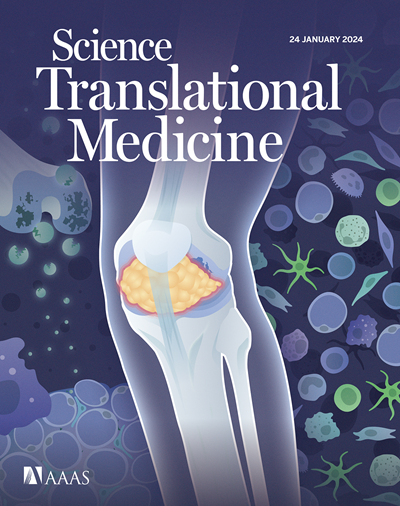衣康酸抑制小鼠外伤性脑损伤后小胶质细胞MG的急性促炎激活
IF 15.8
1区 医学
Q1 CELL BIOLOGY
Science Translational Medicine
Pub Date : 2025-03-12
引用次数: 0
摘要
创伤性脑损伤(TBI)迅速触发小胶质细胞的促炎激活,导致TBI后继发性脑损伤。尽管能量代谢在形成免疫细胞的炎症表型和功能方面的控制作用已被越来越多地认识到,但对脑外伤后小胶质细胞生物能量学的具体改变仍然知之甚少。乌头酸,一种由乌头酸脱羧酶1 [IRG1]产生的代谢物;由免疫应答基因1 (Irg1)编码],是免疫细胞,特别是巨噬细胞中关键的代谢调节因子。由于小胶质细胞是脑实质的巨噬细胞,IRG1/itaconate通路可能调节小胶质细胞的炎症反应。在这项研究中,我们通过小鼠控制皮质冲击(CCI)模型探讨了IRG1/itaconate通路在脑外伤后调节小胶质细胞生物能量学和炎症激活中的作用。我们在脑损伤前、4小时和12小时分离小胶质细胞,观察到糖酵解迅速但短暂的增加,并在损伤后延长线粒体代谢的中断。尽管Irg1表达上调,但创伤后小胶质细胞中的itaconate表达下降。小胶质细胞特异性Irg1基因敲除(Irg1- mi - ko)会加剧代谢变化,增强促炎激活和神经变性,并加重某些长期神经功能障碍。补充4-辛酯衣康酸(OI)恢复了葡萄糖、谷氨酰胺和脂肪酸的使用和氧化代谢,从而增强了脑外伤后小胶质细胞的生物能量。补充OI还能减轻促炎激活和神经退行性变,改善长期神经预后。这些结果表明,治疗靶向衣康酸途径可以改善创伤后小胶质细胞能量代谢和神经系统预后。本文章由计算机程序翻译,如有差异,请以英文原文为准。
Itaconate restrains acute proinflammatory activation of microglia MG after traumatic brain injury in mice
Traumatic brain injury (TBI) rapidly triggers proinflammatory activation of microglia, contributing to secondary brain damage post-TBI. Although the governing role of energy metabolism in shaping the inflammatory phenotype and function of immune cells has been increasingly recognized, the specific alterations in microglial bioenergetics post-TBI remain poorly understood. Itaconate, a metabolite produced by the enzyme aconitate decarboxylase 1 [IRG1; encoded by immune responsive gene 1 (Irg1)], is a pivotal metabolic regulator in immune cells, particularly in macrophages. Because microglia are macrophages of the brain parenchyma, the IRG1/itaconate pathway likely modulates microglial inflammatory responses. In this study, we explored the role of the IRG1/itaconate pathway in regulating microglial bioenergetics and inflammatory activation post-TBI using a mouse controlled cortical impact (CCI) model. We isolated microglia before and 4 and 12 hours after TBI and observed a swift but transient increase in glycolysis coupled with a prolonged disruption of mitochondrial metabolism after injury. Despite an up-regulation of Irg1 expression, itaconate in microglia declined after TBI. Microglia-specific Irg1 gene knockout (Irg1-Mi-KO) exacerbated metabolic changes, intensified proinflammatory activation and neurodegeneration, and worsened certain long-term neurological deficits. Supplementation with 4-octyl itaconate (OI) reinstated the use and oxidative metabolism of glucose, glutamine, and fatty acid, thereby enhancing microglial bioenergetics post-TBI. OI supplementation also attenuated proinflammatory activation and neurodegeneration and improved long-term neurological outcomes. These results suggest that therapeutically targeting the itaconate pathway could improve microglial energy metabolism and neurological outcomes after TBI.
求助全文
通过发布文献求助,成功后即可免费获取论文全文。
去求助
来源期刊

Science Translational Medicine
CELL BIOLOGY-MEDICINE, RESEARCH & EXPERIMENTAL
CiteScore
26.70
自引率
1.20%
发文量
309
审稿时长
1.7 months
期刊介绍:
Science Translational Medicine is an online journal that focuses on publishing research at the intersection of science, engineering, and medicine. The goal of the journal is to promote human health by providing a platform for researchers from various disciplines to communicate their latest advancements in biomedical, translational, and clinical research.
The journal aims to address the slow translation of scientific knowledge into effective treatments and health measures. It publishes articles that fill the knowledge gaps between preclinical research and medical applications, with a focus on accelerating the translation of knowledge into new ways of preventing, diagnosing, and treating human diseases.
The scope of Science Translational Medicine includes various areas such as cardiovascular disease, immunology/vaccines, metabolism/diabetes/obesity, neuroscience/neurology/psychiatry, cancer, infectious diseases, policy, behavior, bioengineering, chemical genomics/drug discovery, imaging, applied physical sciences, medical nanotechnology, drug delivery, biomarkers, gene therapy/regenerative medicine, toxicology and pharmacokinetics, data mining, cell culture, animal and human studies, medical informatics, and other interdisciplinary approaches to medicine.
The target audience of the journal includes researchers and management in academia, government, and the biotechnology and pharmaceutical industries. It is also relevant to physician scientists, regulators, policy makers, investors, business developers, and funding agencies.
 求助内容:
求助内容: 应助结果提醒方式:
应助结果提醒方式:


